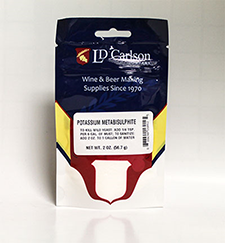Potassium Sorbate and Sulfites: The Dynamic Duo of Sweet Winemaking
Posted by Matteo Lahm on 7th Mar 2024
Ever wonder about the relationship between potassium sorbate and sulfites, and why your wine has banana off-flavors if you use potassium sorbate by itself? Well, there is a very good reason. Shall we continue?
Potassium sorbate, known in the scientific community as C6H7KO2, is a white crystalline powder that's commonly used as a food preservative. It's the potassium salt of sorbic acid, a compound that naturally occurs in the berries of the mountain ash tree. In winemaking, potassium sorbate plays a crucial role as a preservative, working to inhibit yeast from further fermenting the sugar in the wine.
The chemical process behind this is quite fascinating. Yeast cells, through the process of fermentation, consume sugar and convert it into alcohol. When potassium sorbate is introduced into the mix, it interferes with this process. Specifically, potassium sorbate inhibits the metabolic pathways that yeast cells use to reproduce. By blocking them, potassium sorbate effectively halts further fermentation. This is particularly important in the production of sweet wines.
By using potassium sorbate, winemakers can control the fermentation process, by either halting fermentation to preserve the desired sweetness or after the wine has fermented dry prior to back sweetening, which is the preferred technique. It is much easier to stunt yeast when they are starved for sugars than when they are in the middle of a banquet. Not only will you will need more potassium sorbate and sulfites to effectively halt active fermentation, it probably won't work unless you also chill it. More potassium sorbate will mean a higher likelihood of off-banana flavors. More sulfites can lead to a burnt matches taste which you definitely do not want. Healthy yeast mount a more formidable defense. Best to let the yeast finish and attack them while they are weakened. If you want a lower ABV, you should adjust the brix of your solution prior to fermentation so you can just let it ferment dry.
The only exception are fortified wines where the ABV exceeds the maximum alcohol threshold of the yeast. If you add brandy or any other distilled alcohol to make a port, and your final ABV exceeds 18%, you can add more sugar without fear that there will be additional fermentation. The high alcohol level will kill off the yeast. Aside from this exception, if you are making a sweet wine, you will need to the potassium sorbate and sulfites combination, especially if your final ABV is below the alcohol threshold of your yeast. Introduce more sugar, fermentation will start again. If you bottle, you will need body armor to enter your wine cellar to protect yourself from cork projectiles. Those gases need to go somewhere. Your bottles can and will pop from the pressure.
So if you were wondering why you cannot use potassium sorbate by itself, now you know. It is the cause of peculiar banana off-flavors in your wine. This happens because potassium sorbate inhibits yeast, but it doesn't kill it. The yeast, in a last-ditch effort to survive, produces an enzyme called UDC (Urea Degrading Enzyme), which reacts with the sorbate to produce ethyl sorbate, a compound that has that distinct banana-like aroma.
So, unless you're aiming for a Chiquita-themed wine, you might want to avoid using potassium sorbate alone. But don't worry, your trusty sidekick, sulfites, are here to save the day. The sulfites serve to weaken the yeasts while potassium sorbate is doing its job. When used together, sulfites can help control the yeast population, reducing the chances of the banana off-flavor. In this particular process, they are like the Batman and Robin of winemaking.
But remember, like any dynamic duo, potassium sorbate and sulfites need to be used in the right proportions. Too much of either can lead to off-flavors and aromas. The correct potassium sorbate dose is typically 1/2 tsp per gallon of wine and it is advisable not to exceed that. It's like adding too much salt to your soup; you don't want to overpower the natural flavors of the wine. If you want to limit your sulfites, you can. You can add as little as 1/8 of a teaspoon when using potassium sorbate per 6 gallons of wine. You need just enough to stop the yeast from fighting back against the potassium sorbate. The less virile the yeast are, the less havoc they can cause in your wine. It is the equivalent of running a race and your yeast is an Olympic sprinter. If they are healthy, you’ll probably lose. Mr. Sulfites is the loan shark muscle man who will ensure that your yeast will be walking with crutches on race day.
So, that’s the skinny on why you use potassium sorbate with sulfites. Together, they work to keep your wine stable and delicious, preventing any unwanted banana shenanigans.
Now that you are in the know, the next time you're sipping on a glass of your back sweetened homemade wine, that is not banana flavored, raise a toast to potassium sorbate and sulfites. Using them together is why Batman and Robin go home with just a few scrapes and bruises instead of broken bones, and why your blueberry wine does not taste and smell like a banana split. Cheers!



